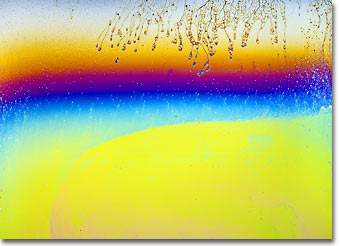Karl E. Deckart
Soap Bubble Gallery: Image Twenty-One
German photographer and artist Karl E. Deckart is known for his thorough, precise, and beautiful work both in photography through the microscope and with macro camera systems. This gallery of interference photographs made with soap films is a testament to both Deckart's skill as a photographer and his understanding of the physical phenomena that surround our everyday lives. Presented below is soap bubble image number twenty-one in small format. Click on the image to download a larger version.

|
Macrophotography of thin soap films freely suspended on a 4 x 4-inch wire frame was conducted with a Linhof large-format bellows camera system utilizing 4 x 5-inch sheet film and imaged using an apo-macro Nikon large format Nikkor-AM ED 210 mm f-5.6 lens. To prepare the soap film, equal parts of water, glycerin, and dishwasher detergent are thoroughly mixed in a container until a solution containing evenly sized micelles is achieved. A freestanding film is formed by dipping the wire frame into the solution and withdrawing carefully to maintain an even film thickness and avoid disruption of material flow across the frame rails. After suspension, the film was illuminated by a reflected light source positioned a few degrees from the camera system. The light was passed through a diffusion screen to avoid bright spots and provide an even illumination across the field. No polarizers were employed in photomacrography of soap thin films. Image ©1999 by Karl E. Deckart. All rights reserved. |
The delight of bubble blowing was captured in a seventeenth century Flemish painting that illustrated children at play with clay bubble pipes. Fascination with blowing bubbles became an American national past time at the beginning of the twentieth century when soapy mixtures were sold as a toy by street peddlers and pitchmen. Bubble-making solutions are generally a mixture of dishwashing-type detergent, water and sometimes glycerin. An early formula was made commercially available in the 1940's by a chemical company named Chemtoy. Receiving heightened popularity from flower children of the 1960's, bubble blowing came to symbolize peace and harmony, a tradition that continues today.
BACK TO THE SOAP BUBBLE GALLERY
